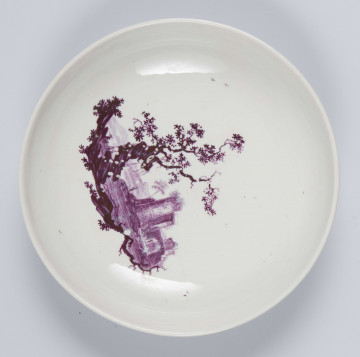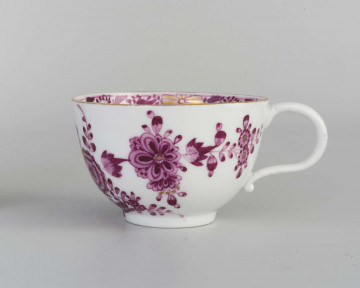
Creamer jug
1825 — 1835
National Museum in Lublin
Part of the collection: European porcelain 18th/19th c.
The single-colour, purple-painted decoration imitates the form of book vignettes, popular at the time. These were graphic compositions, figural or ornamental, originally based on vine motifs (French vigne). They were placed in books as decorations of the title page, at the beginning or end of the chapter, or as a filling at the bottom of the page. Graphic patterns were a basic source of inspiration for craftsmen from various fields, including pottery makers. Picturesque ruins in a landscape is a motif connected with the sentimentalism current, popular both in painting and garden art of the last quarter of the 18th century.
The cup and saucer were made in a small porcelain factory in Fulda, Germany. The city, situated on the river of the same name, developed around the Benedictine Monastery founded in the 8th century. The Abbey's territory, which was granted by the Emperor, became a sovereign principality over time. In 1752, Fulda became a bishopric and the abbots were given the additional title of prince-bishop. Prince-Abbot Heinrich von Bibra established a porcelain factory here in 1764, employing Nikolaus Paul, an experienced arcanist from Berlin. The factory did not operate for long - only until 1789 - but its products nevertheless managed to reach a high technical level. The decoration was mainly single-colour paintings in purple or iron red in the style of Louis XV.
Barbara Czajkowska
Author / creator
Dimensions
cały obiekt: width: 5 cm
Object type
dish
Technique
underglaze paints
Material
porcelain
Creation time / dating
Creation / finding place
Owner
The National Museum in Lublin
Identification number
Location / status

1825 — 1835
National Museum in Lublin

1764 — 1789
National Museum in Lublin

1774 — 1814
National Museum in Lublin
DISCOVER this TOPIC
National Museum in Szczecin
DISCOVER this PATH
Educational path